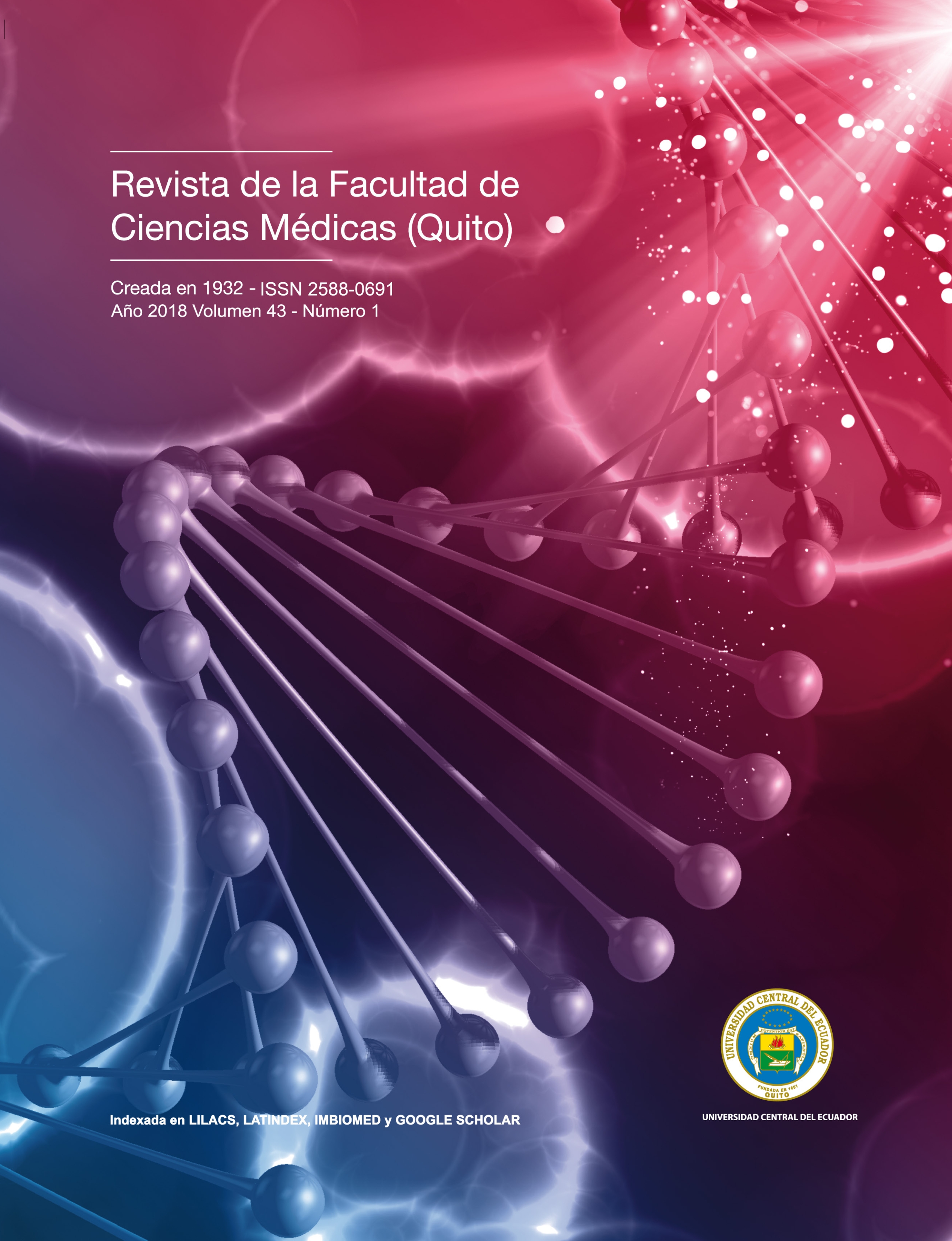Bloqueo laparoscópico subcostal del plano transverso abdominal (TAP) como analgesia multimodal postquirúrgica en pacientes con patología biliar
DOI:
https://doi.org/10.29166/ciencias_medicas.v43i1.1466Keywords:
Postoperative pain, Subcostal block, Postoperative analgesia, Transverse abdominal plane, Laparoscopic blockageAbstract
Context: the postoperative pain is one of the main problems in surgical practices; it must be adequately treated to achieve a favorable evolution in the patient. Objective: To evaluate the laparoscopic subcostal block of the transverse plane of the abdomen with 0.5% of bupivacaine, versus the non-block in adult patients that had surgery of biliary pathology at San Francisco de Quito Hospital.
Methodology: epidemiological study of cases and controls of patients that were admitted to the San Francisco de Quito Hospital. There are 210 patients equally divided in two groups, in the first group the subcostal block was applied, while in the other group was without intervention. The two groups were observed and assessed for 24 hours. The quantitative variables were reported as averages (± SD, Standard Deviation) and qualitative variables with their absolute and relative values (percentages) were also reported as well. The comparisons of quantitative variables were performed with a t-Student test, while the comparison of qualitative variables was performed with independent tests for proportions x2 and Fisher's exact test.
Results: compared with the second group, the rate of analgesia for rescue was significantly lower in patients who received laparoscopic block with 0.5% bupivacaine (28.6% vs. 51.4%, respectively). The reduction in the use of analgesics was of 22.9% on average (95% CI: 36.7, 9%, p = 0.0012), equivalent to an OR: 0.38 (95% CI: 0.21, 0.67, p = 0.004). ORad = 0.38 (95% CI: 0.21, 0.67, p <0.01). The use of opioids was lower in the group with block compared to its control (46.7% vs 59.3%), the use of paracetamol was higher (30% vs 18.5%) and in the use of non-steroidal analgesics (NSAIDs), the result was similar (23.3% vs 22.2%).
Conclusion: laparoscopic subcostal block is shown as an effective technique for pain control and treatment in patients that had surgery with biliary pathology, reducing the use of analgesia on average during the first 6 hours
Downloads
Metrics
References
Brennan T. Pathophysiology of postoperative pain. Pain. 2011; 152(Supplement):S33-S40.
Sancho, C. V. G., Bergón, E. C., & Cajaraville, J. P. Dolor agudo postoperatorio. Dolor: Investigación, clínica & terapéutica, 15(4), 280-288.
Finnerty O1, Sharkey A, Mc Donnell JG. Transversus abdominis plane block for abdominal surgery.Minerva Anestesiol. 2013 Dec;79(12):1415-22.
Tazuma S. Gallstone disease: epidemiology, pathogenesis, and classification of biliary stones (common bile duct and intrahepatic). Best Pract Res Clin Gastro- enterol 2006;20:1075–83.
Kathleen O’Connell, Karen Brasel. Bile Metabolism and Lithogenesis. Surg Clin N Am 94 (2014) 361–375
Maringhini A, Ciambra M, Baccelliere P, et al. Biliary sludge and gallstones in pregnancy: incidence, risk factors, and natural history. Ann Intern Med 1993; 119:116–20
National Center for Health Statistics, Plan and operation of the Third National Health and Nutrition Examination Survey 1988-94. Vital Health Stat 1 1994;(32): 1–407
Yoo EH, Lee SY. The prevalence and risk factors for gallstone disease. Clin Chem Lab Med 2009;47:795–807.
Erlinger S. Gallstones in obesity and weight loss. Eur J Gastroenterol Hepatol 2000;12:1347–52.
Brufau G, Stellaard F, Prado K, et al. Improved glycemic control with coleseve- lam treatment in patients with type 2 diabetes is not directly associated with changes in bile acid metabolism. Hepatology 2010;52:1455–64.
Knab, Lawrence M. et al. Unusual Complications of Gallstones. Unusual Complications of Gallstones
Ansari, Selim, Banu, Sabina, Awal, M.A, Bakkar, Abu, Alam, Monjur. 2007. Polypoid gallbladder lesions: Is it necessary for immediate surgery. Bangladesh Medical research Council. 33: 44-47.
Shin, Su Rin, Kyun Lee, Jong, Hyuck Lee, Kwang, Taek Lee, Kyu et al. 2009. Can the growth rate of a gallbladder polyp predict a neoplastic polyp? Journal of Clinic gastroenterology.Lippincott 43(9): 865-868.
Cavina E, Franceschi M, Sidoti F, Goletti O, Buccianti P, Chiarugi M. Laparo-endoscopic "rendezvous": a new technique in the choledocholithiasis treatment. Laparo-endoscopic "rendezvous": a new technique in the choledocholithiasis treatment.
Kelly DJ, Ahmad M, Brull SJ. Preemptive analgesia I: physiological pathways and pharmacological modalities. Can J Anaesth 2001; 48:1000.
Aubrun F1, Marmion F. The elderly patient and postoperative pain treatment. Best Pract Res Clin Anaesthesiol. 2007 Mar;21(1):109-27.
Beloeil HMazoit J. Farmacología de los anestésicos locales. EMC - Anestesia-Reanimación. 2010;36(4):1-18.
Saxena A, Bansal R, Mittal A, Shrivastava U, Sharma P, chand T. Evaluation of postoperative analgesic efficacy of transversus abdominis plane block after abdominal surgery: A comparative study. Journal of Natural Science, Biology and Medicine. 2013;4(1):177
Rafi A. Abdominal field block: a new approach via the lumbar triangle. Anaesthesia. 2008;56(10):1024-1026.
Magee C, Clarke C, Lewis A. Laparoscopic TAP block for laparoscopic cholecystectomy: Description of a novel technique. The Surgeon. 2011;9(6):352-353.
Hebbard P. Subcostal Transversus Abdominis Plane Block Under Ultrasound Guidance. Anesthesia & Analgesia. 2008;106(2):674-675.
Santeularia Vergés M, Català Puigbò E, Genové Cortada M, Revuelta Rizo M, Moral García M. Nuevas tendencias en el tratamiento del dolor postoperatorio en cirugía general y digestiva. Cirugía Española. 2009;86(2):63-71.











